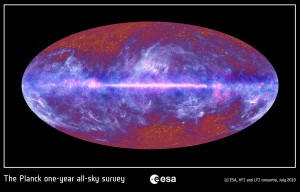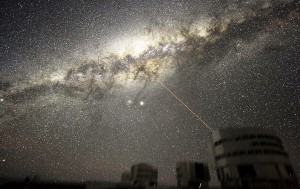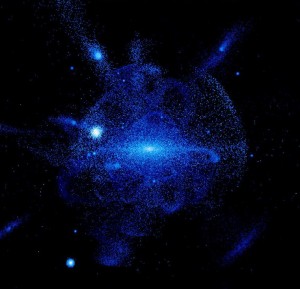
As soon as I got over the fainting spell from looking at the Planck satellite’s map – and if you haven’t seen it, look now, faint, and then click – showing the Milky Way, I had a burning question.

Okay, true, the Planck satellite wasn’t intended to map the Milky Way. It was supposed to map the background of microwaves left over from the Big Bang (the reddish stuff above and below), but the Milky Way was between the Big Bang and Planck, and it got in the way. And true, that map doesn’t look like the Milky Way which I always thought of an uneven splash of stars across the night sky. But the Planck picture is the zoomed-out view of that night-sky splash, and we see the splash because the Milky Way is a spiral galaxy and we’re inside it, seeing it edge-on, looking toward the center. I grant that this is a confusing number of reference frames and I apologize for digressing.
Back to the subject: my question was about the Planck map and those lovely wisps of gas. Gas can turn into stars. Were those wisps really streams of stars, or were they maybe tracing out where streams of stars ran, or were they maybe streams of stars not born yet?
Nope. Gas wisps aren’t related to star streams, says Heidi Newberg at Rensselaer Polytechnic Institute, “though everyone sees the similarity and wonders if there is a relationship.” Gas wisps are probably something like the remnants of bubbles from supernova blow-ups, says UC/Santa Cruz’s Connie Rockosi, and some of them look so big because they’re nearby and “we are sort of craning our necks looking up at them.” Gas wisps in the Planck map are really relatively small; star streams are enormous.

Rockosi and Newberg know these things because they’re astronomers studying the Milky Way, which turns out not to be a lonely, lovely spiral floating in the blue, but a big corporate spiral that pulls in any nearby dwarf galaxies and merges them into its own self. In the process, the dwarf orbits the Milky Way, shedding stars in long, looping streams. For a long time, those streams stay together, their stars remembering their parent dwarf, until the dwarf comes apart completely and finally everything disappears into the Milky Way.
This has happened repeatedly: a picture of the Milky Way zoomed back even farther than Planck’s map, shows the star streams from a handful of broken dwarfs, flying up and around like banners. The galaxy looks like a carnival in full swing.
Nice when you can be so dead wrong about something and what’s right instead is such a delight. All these pictures are prettier if you click and enlarge them. Meanwhile, interested in that Planck map? Bad Astronomer has a good write-up. Want to help Newberg map those star streams? MilkyWay@home.
Photo credits:
Planck map: ESA/ LFI & HFI Consortia
Milky Way at night: ESO/Yuri Beletsky
Milky Way star stream: K. Johnston, J. Bullock